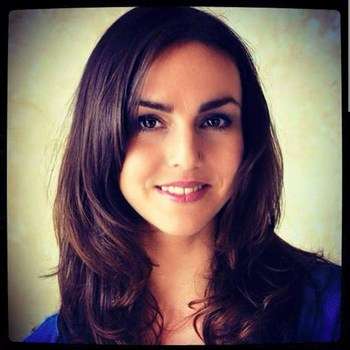Julia Tulsi Bagnoli is a teacher of both yoga and Transcendental Meditation. She is a combination of beauty, grace and bliss that folds without effort into incredible shapes — both mentally and physically. We talked with Tulsi about the role of yoga on the path to enlightenment, and what it feels like NOT to meditate.
 Learning to meditate
Learning to meditate
You learned Transcendental Meditation when you were just a little kid. What do you remember from that time?
JULIA TULSI BAGNOLI: I remember the day like it was yesterday! I remember asking if I could learn the technique. I picked out my favorite party dress and my favorite fruit. I very much looked up to my uncle, so I was very excited that he was the one teaching me. I remember walking down the hallway and smelling the incense and when he opened the door he looked like an angel. The moment he gave me my mantra, I felt, “Oh, I am home!”
Really interesting that even as a four-year-old you had that desire to learn to meditate.
JULIA TULSI BAGNOLI: I guess it was because meditation has always been part of my life. I am a fourth-generation meditator who was born into a family of yogis. My mother practiced yoga and meditation every day while she was pregnant with me. My parents used to do baby yoga with me. I had very blissful, sweet and nourishing parents so I really wanted to have what they had. I saw them meditating and I wondered, “Can I do that too?”
When people ask me what my earliest childhood memories are, one of the earliest things I recall is the memory of sitting in my mother’s lap in the meditation hall in Fairfield, Iowa, listening to Maharishi’s voice.
Usually people learn the TM technique when they are ten, but since my parents were teachers of TM I was able to learn at nine and a half. My mother and I were living in Hawaii at the time, and I remember being very excited to learn the technique and asking her, “It’s my half-birthday, can I learn?” Looking back, it was actually a month short of my half-birthday but I was just so excited to be able to sit down and meditate.
Has there ever been a time when you have not practiced Transcendental Meditation regularly?

Photo: Christian Adam.
JULIA TULSI BAGNOLI: There was actually a short time in my life when, can you believe it, I forgot to meditate!
It happened when I moved back to Hawaii as a teenager. Coming from the Maharishi School in Iowa, where I had 70 classmates whom I had grown up with, I arrived at Maui High with 2,400 students. So, all of a sudden, it was this big, bright world of new friends, the ocean, surfing, hiking and reggae music.
For a few months I was just enjoying it all, and then I remember that life became very hard. I called my mom and said, “I live in a paradise, but life has become really hard!”
My mother asked, “So when was the last time you meditated?” And I said, “I’ll call you back later.”
I sat down and even before I began meditating I started laughing. I had been like a gardener who was only enjoying the fruits and flowers and who had forgotten to water the roots or tend to the nourishment of the tree! I felt like an idiot but at the same time, when I began to meditate again, I realized I would never again take this practice for granted.
That was the beginning of the transition to finding TM for myself. You sometimes have to take that journey to remember and appreciate what you have. And this experience was part of my path, from fully receiving it from my parents, to experiencing what it’s like to not have that inner peace, to finally understanding, “Oh! This is a part of why I enjoy everything!”
Becoming a teacher
How did yoga become such an integral part of your life?
 JULIA TULSI BAGNOLI: I had been doing it ever since I was a little kid. But I only became serious about my dedication to my practice after I was in a car accident. It was kind of a miracle because my car was completely totaled and I was nearly untouched. A couple of weeks later I started to feel the injury in my neck, and my mother invited me to come back home to Iowa. The classes at Maharishi University of Management (MUM) were supposed to start the next week, and so my mom suggested that I enroll.
JULIA TULSI BAGNOLI: I had been doing it ever since I was a little kid. But I only became serious about my dedication to my practice after I was in a car accident. It was kind of a miracle because my car was completely totaled and I was nearly untouched. A couple of weeks later I started to feel the injury in my neck, and my mother invited me to come back home to Iowa. The classes at Maharishi University of Management (MUM) were supposed to start the next week, and so my mom suggested that I enroll.
At that time I was determined that I wanted to learn marine biology in Hawaii and save reefs in the ocean. But my mom said, “I want you to stay here and be nourished, so why don’t you go to MUM for six months?”
I was really stubborn, so I said, “Okay, but only six months!”
Throughout that whole time I kept stating my story: “Oh, I’m only here for a semester.” It’s nice to look back at how actually there was this ‘not knowing’!
In reality, by year two I was taking some first-year classes and ended up getting a degree. It was in one of my Science of Being classes with Professor Evan Finkelstein that I realized, “This is all you need in life!” Not as in there is nothing else I need to learn, just that with the integration of this knowledge and experience, you can find everything else that you are looking for.
In one of my classes we did an exercise with three Venn diagrams where you write down everything you like to do in life, everything you are good at doing and how you can help the world. Where all three circles overlapped I had written: yoga and adventures. I had this understanding about the body because I had been steady in this practice for a long time. Not the intellectual understanding, but this knowing of how to listen to the body while being gentle and effortless.
 To become a TM teacher was another path I wanted to take. I applied and got accepted to the training even though I was younger than required. I raised the money for the course within a few days. It felt very much meant to be.
To become a TM teacher was another path I wanted to take. I applied and got accepted to the training even though I was younger than required. I raised the money for the course within a few days. It felt very much meant to be.
Meanwhile, I was also studying with a yoga teacher in Fairfield and she would keep asking me, “When will you start teaching yoga?”
And I would say, “I will begin teaching when I take proper training.” Months would pass and she would ask again, “When are you going to start teaching yoga?”
So I would tell her, “When I can breathe into my feet.” I felt my whole body wasn’t breathing fully; I was aware of that.
I didn’t want to learn with just anyone, so I went on a pilgrimage to find a teacher who was part of a traditional lineage and steeped in the proper knowing of why we practice yoga and where it comes from.
I traced the roots back to Sri Tirumalai Krishnamacharya. I found his longest-standing disciple outside the family, Sri Srivatsa Ramaswami, who at the time was 73 years old. He was very well versed in the scripture and very simple. He embodied yoga. I completed my first 200-hour training with him just after finishing my Master’s degree from MUM.
I most recently took advanced training in the Himalayas and traveled all over India for a total of nine months.
Nine months in India
While you lived in India, how easy or difficult was it for you to reconcile the contrast between the material poverty and spiritual wealth of the country?
JULIA TULSI BAGNOLI: It was a huge contrast compared to the United States, and it is a fine line. I’m very sensitive and obviously one can sense that neediness. Yet you know that the beggars might get a dollar from you but not have any of it, because there are other middlemen involved.

Meditating at Maharishi’s ashram. Photo: Mel Sauerbeck.
I had to come to a place of no ego. I could not compare, could not judge. It was a fine line because you can easily go into sadness and wonder for the rest of the day where that woman and that child are going to sleep tonight.
I remember one time walking in the Himalayas and we visited this small village. There was a couple who had terraced the side of their home into a garden. It was a two-story building, almost adobe style, but very simple. There was not even a door, just a hanging piece of burlap that came down and an earth floor. They barely had any possessions and they slept on a clay bed.
Someone in our group asked the man, “If you had three wishes, what would they be?”
And he said, “I have no wishes; I have everything that I need. I am very content and fulfilled. I have this beautiful view of the mountains, I have shelter, I have my lovely wife, I have food, my children were raised in this village and have gone to college and now have jobs in the city. I am very content. There is nothing that I need.”
It makes you think: How many people in the West do you know who feel the same? How to even go about comparing the material deprivation or abundance versus the spiritual deprivation or abundance?
In India, you’ll go to places like Vrindavan, where Krishna was said to have grown up, and there’s this air that I can only compare to being in the Dome, the meditation hall in Fairfield. You might not speak to anyone while you meditate, but there is this common thread, this common knowingness, this substance that’s holding everyone together, and it is so tangible in India.
You walk into the cave of Vashistha, a great saint. You close your eyes and the timeless takes over your being. Five hours later you wonder why you could not stay any longer when the cave is being closed down for the night.

By the river Ganges, India. Photo: Mel Sauerbeck.
In India it’s even more effortless to bask in your own nature because it’s so supported. You’re drawn in more easily. When you go to a place where many people have meditated for thousands of years, there is this stillness, and it really does permeate India.
There was only one time in India that I felt loneliness. The rest of the time, there was that feeling that I was always taken care of. In a way I had more of a culture shock coming home than going to India.
What made you feel that way?
JULIA TULSI BAGNOLI: I first noticed it during my layover in the airport. You know how whichever way the flow of the traffic goes — like in America, you drive on the right side of the road — that’s how the crowd usually flows too. At the airport, everyone was walking on the right side and I was walking against everyone.

Photo: Todd Cinnamon.
And coming into the Oakland airport I heard people talking about what looked better on them while checking their cell phones at the same time, and I thought, “Welcome home.”
We are here to enjoy. It’s about 200% of life, and we don’t want to be without this world. But you want to be very conscious of what you bring into your life. Yes, you can love everyone, but you don’t have to welcome everyone into your home.
At the same time, we walk this path so we can help others. It was a great way for me to find non-judgment and not to think we can guide others by describing where we are at: “I’m at the top of this mountain, and let me tell you, there are these beautiful flowers and fresh air here. Come join me!”
I have to remember where we have all come from and where we can all go and step by step help other people to put the right foot in front of the left. Sometimes you have to join them in that darkness and still whisper something. It really helped me find this perspective. Yes, it’s nice to have sunshine and rainbows, but that’s not all the truth.
It’s like that quote by Rabindranath Tagore: “I slept and dreamt that life was joy. I awoke and saw that life was service. I acted, and behold, service was joy.”
You never know when that one person is listening or whom you can learn from. Sometimes the person blinded by anger can be your greatest teacher in that moment. Everyone deserves to be helped and to be listened to and to be thought of equally.
200% of life: Follow your Self
You teach both Transcendental Meditation and yoga. For you, how do the two complement one another?
JULIA TULSI BAGNOLI: There are some people who have this belief that they are not able to sit still. Or that they don’t want to be spiritual and that meditation somehow involves spirituality. There are many walls and veils that we can put up. It’s like that Rumi quote: “Your task is not to seek for love, but merely to seek and find all the barriers within yourself that you have built against it.”

Photo: Ivan Ditscheiner.
Meditation takes us right there. We slip in innocently, like a drop of water returning to the ocean.
Yet some people are not ready for it, and they need one more taste to draw them deeper. Yoga is a nice way of helping take down those walls, whether physical pain or destruction in the mind. In the modern world, we’ve forgotten the purpose of yoga, which is to help prepare the mind and body for meditation.
Sometimes yoga can light this fire inside, this yearning: “What comes next? I want more!”
Some people come to my yoga class just for the exercise and then they experience the benefits. So one day they say, “I’m curious— tell me a little more about this.”
So, for me, yoga is that gateway to either taking down those walls or sparking that inner fire, to acquire the thirst for more. Whenever people are ready, they will approach. So I like to be here on all these different levels.

Spreading the light.
Yoga is also constant practice. I feel that I am always learning more from my students than they do from me. I have to be softer for them to experience more softness; I have to be deep to help encourage and open space for them to go deeper.
Being a teacher of Transcendental Meditation is definitely the heart of what I believe I am here to offer and share and give to others. Every single time I teach someone TM I just sit there and say “Thank you!” inside. It’s a great honor and joy to be a part of this lineage, and I would not choose to do anything else with my life.
What would be your personal message to a person who is considering learning Transcendental Meditation?
JULIA TULSI BAGNOLI: If there is any desire, any yearning they have in their life, it can be truly quenched only by first knowing the Self. Developing the Self is the one thing they should do, and the rest will come on its own.
*
Julia Tulsi Bagnoli
Julia Tulsi’s initiation into meditation and yoga came from her parents, who were teachers of Transcendental Meditation trained by Maharishi Mahesh Yogi. From the age of four she would sit with her parents for morning and evening sadhana (practice), basking in the experience of samadhi. To truly understand and appreciate the gifts she had been given, Tulsi began to walk her own path and experience the journey through her own eyes. A true search and yearning for the divine blossomed through her late teens and led her also to become a teacher of Transcendental Meditation and Hatha yoga at the age of 20. She continued to practice and teach both yoga and meditation while attending Maharishi University of Management, where she completed an M.A. in Vedic Science with an emphasis in Sanskrit chanting in 2009.

Tulsi (holy basil) is known as “the queen of herbs” in Ayurveda and is used for relieving stress and energizing and uplifting one’s mood. Tulsi leaves are offered in acts of devotion, and malas (beads) are made of Tulsi wood and are worn to bring one closer to the divine.
Tulsi continued her training that same year to become a certified teacher in the Vinyasa Krama style of yoga with Sri Srivatsa Ramaswami, in the lineage of Sri T. Krishnamacharya. During 2012–2013 she spent six months teaching and studying yoga in India, where she completed a 300-hour teaching training course in the foothills of the Himalayas. After a lifetime of study, Tulsi is currently completing certification as an Ayurveda Wellness Consultant and is looking forward to integrating Ayurveda into her teachings.
Her passion lies in teaching an elevating class where students explore methods of the eight-limbed path of Ashtanga Yoga, while cultivating flexibility, core strength and connection to Spirit through deep awareness and breath. Her style is a graceful, yet vibrant integration of solar and lunar energies within the body, mind and soul. Tulsi conducts her classes based on her intuitive sense of each student’s need, so every class is a unique experience in self-exploration.
Tulsi is currently a Certified Teacher of Transcendental Meditation in San Luis Obispo County, columnist for Caribbean BODY & SOUL magazine and Ambassador of Yogitunes.com, music streaming for the yogic lifestyle. Tulsi teaches weekly classes and workshops at Smiling Dog Yoga, SLO Yoga Center, SLO Op Climbing Gym, and Cal Poly University Rec Center in San Luis Obispo, CA.
This article originally appeared on TM Home at: www.tmhome.com
Sign up for the next talk nearest you on our site at: http://switzerland.tm.org/web/m/find-a-teacher

 English
English


